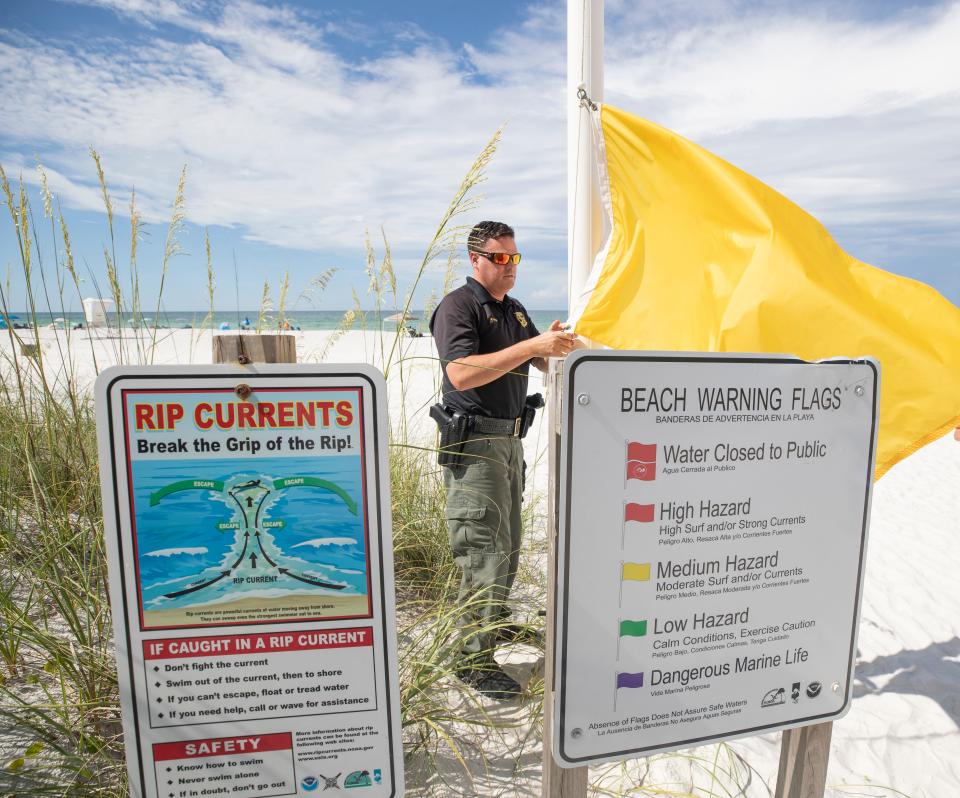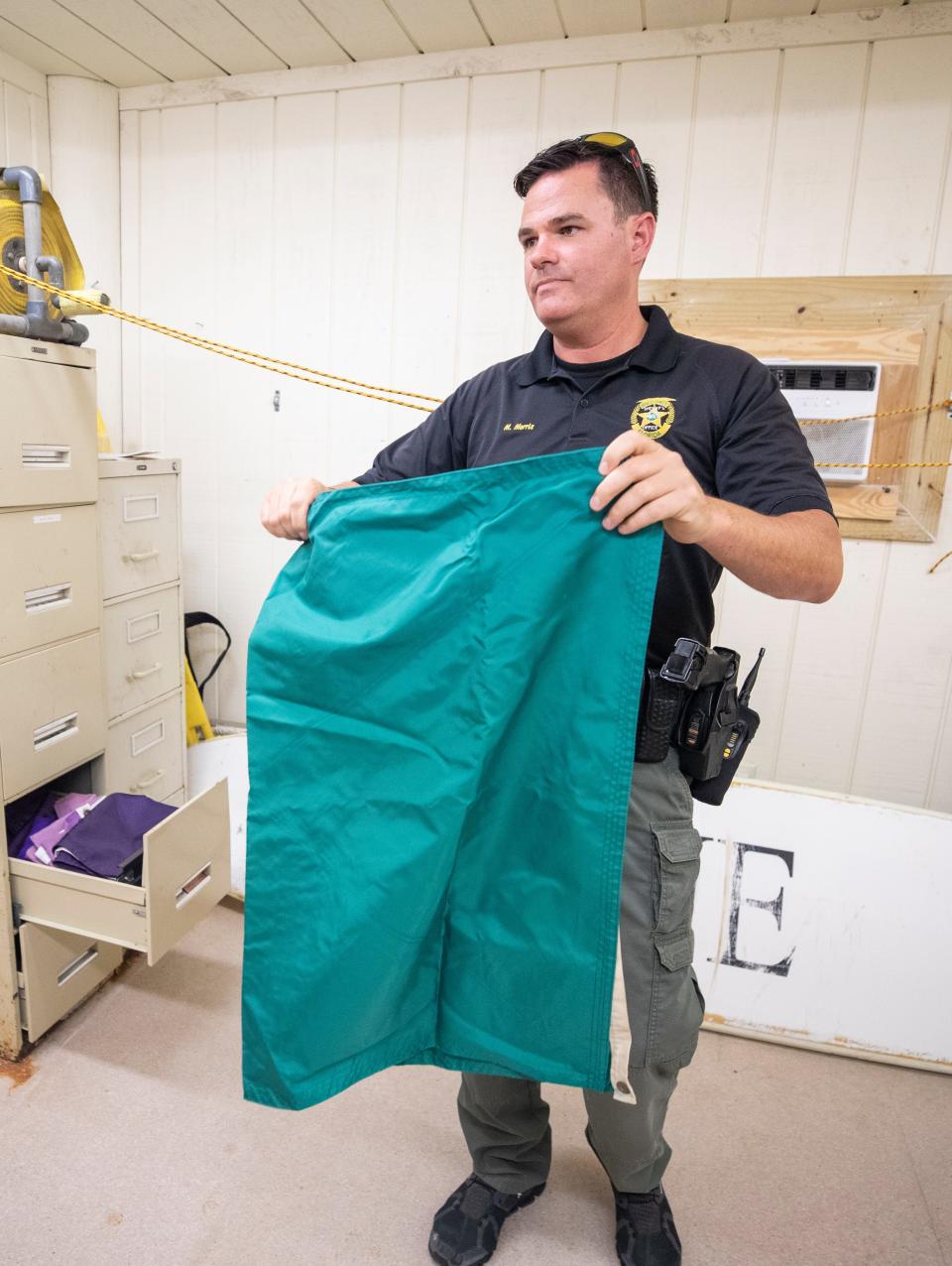Green flags no longer fly on Panama City Beach: Officials say Gulf has ever-present danger
PANAMA CITY BEACH — Green flags flying at the beach mean calmer waters, but don't expect to see any.
Beach and county officials who erect the flags signaling water conditions say green basically gives people the wrong impression or, according to Ruth Corley, public information officer for the Bay County Sheriff's Office, "a false sense of security."
The sheriff's office responded to two drownings last year, but none so far this year, said BCSO Sgt. Mike Morris said. Wil Spivey, Beach Safety Division director for Panama City Beach Fire Rescue, said the city counted six drownings last year, and two so far this year.
Bay County EMS records combine drownings and near drownings on its call summary report. The report for 2021 lists 151 drownings or near drownings, 117 water rescues and 61 unknown emergencies on the water.
This year's tally, through June 21, lists 79 drownings or near drownings, 72 water rescues and 34 unknown calls for help on the water.
And that's a key reason, officials say, they won't fly green flags to signal "calm conditions, exercise caution."
Spivey is adamant: No green flags have flown for at least the 13 years he's been on the job, due to the "moderate degree of hazard present in that open body of water (Gulf of Mexico)."

Spivey said most people that his agency has been called on to assist are people who shouldn't be going into the water in the first place.
"I highly recommend non-swimmers do not enter the Gulf of Mexico without wearing a Coast Guard-approved personal flotation device that properly fits, even on a yellow-flag day and even then they should swim near a lifeguard," Spivey said.
'Making some progress': PCB sees big drop in number of swimmers ticketed during double-red flags
Never-ending job: $125K in double-red flag fines? 1,700 rescues? Swimmers have kept PCB busy
The exception: "Experienced surfers with knowledge of rip currents. They are tethered to their boards, their own personal flotation devices," he said.
Jessica Graham, director of the St. Andrew and St. Joseph Bays Estuary Program at Florida State University, agreed.
"The beach is incredibly dynamic, so it's going to change with every storm," she said. "There should always be a level of caution when you are interacting with the water. The color of flag is really a human aspect of interpretation of what's going on. What you don't see is what's happening under water."
Choosing the color of beach flags
Dozens of red flags spill from a box just inside the sheriff's substation at S. Richard Seltzer Park on Thomas Drive. A smaller box of yellow flags sits nearby. Neatly pressed purple and green flags are stored in a rusty filing cabinet across the room.
"We don't fold the red flags. When they're wet, they'll mold," said BCSO Sgt. Mike Morris.
Morris makes the official call for the color of flag displayed up and down Bay County's stretch of white, sparkling sand.

Deputies, with the assistance of county lifeguards and sometimes firefighters, put up flags on 24 poles stretching from St. Andrews State Park to Ms. Newby's in the 8700 block of Thomas Drive at Joan Avenue, and from Splash Resort in the 17000 block of Front Beach Road west to Camp Helen State Park in Sunnyside, he said.
Spivey said of the 27-mile stretch of beach in Bay County, city lifeguards are responsible for flags on the 25 poles dotting the middle 9.5 miles. This area runs from Beach Access 24 to 76-B. Spivey's division is comprised of 22 employees — six full-time employees, 15 seasonal lifeguards and himself — who cover the beach from 8 a.m. to 10 p.m.
"On a good day, it's going to take us about 30 minutes to get all the flags changed," Spivey said, adding, "We've got eyes on the water all day long. We are constantly monitoring to see what's coming."
Spivey said he looks at wind direction and speed, and he checks surf forecast models and buoy reports from the National Oceanic and Atmospheric Administration.
"A lot of it has to do with the wind. But the outgoing tide, that can increase rip currents," he said. "We're looking at the tide conditions and the direction the swell is approaching us."
Yellow flags typically fly when the water surface appears flat to 1.5 feet. But they can be replaced with red, indicating a high hazard, when the waves hit 1 to 3 feet, he said. The flags are changed to double-red when the waves crest at 3 feet or above.

Conditions calling for double-red flags are when beach-goers are told to stay on dry land and the city's Code Enforcement Department can issue a $500 fine to each person found in the water.
And then there are the animals that call the open saltwater of the Gulf of Mexico home. Purple flags signal the presence of hazardous marine life, such as jellyfish in the area.
But officials say those flags do not indicate the presence of sharks.
"There are sharks out there all the time," Morris pointed out.
Morris said he decides on the proper flag for the entire beach after reviewing the tidal flow, wave height and winds. He also checks websites such as swellinfo.com and magicseaweed.com, and he talks to a meteorologist at the National Weather Service office in Tallahassee about what to expect.
Spivey posts a text alert about 10:10 a.m. daily, announcing flag conditions. Morris sends out alerts earlier to local media to publish or broadcast to the public and throughout the day.
Typically, Morris said, the water appears calmer in the morning, but when winds blow in out of the south or southwest in the afternoon, "That's when we start getting the water (rescue) calls."
And, he said, his agency will switch to the red flags a little early to give people at the beach a heads-up to what's coming.
Rip currents are worse in some spots
While rip currents happen everywhere, a few spots seem to be the most affected. Morris named Treasure Island at Access 4 and the Crescent at Access 12 as trouble spots.
But, he said, the beach renourishment project that was completed in April, left potentially dangerous rip currents primarily on the west end of the beach at Access 88 behind Beachside Resort, and near the Laguna Beach Christian Retreat in the 2000 block of Front Beach Road.
"The dredging left a cutout of the middle and formed a big hole," he said.
As soon as Spring Break hit in March, water rescue personnel were called to help several people struggling against rip currents at Beachside, he said, adding that last year, 12 children were rescued offshore of the property.
Going red: Conditions change rapidly
"(Beach conditions) change on a daily, if not hourly basis, based on the direction of the winds and the waves and how they come in," Graham said.
Most people don't understand how fast, she said.
"They'll let their child walk out on a sandbar and they won't know that at the end of that sandbar is a current that's going to rip around very fast," she said. "Also, people will come here from the East Coast (where the surf is more rough) and they'll see calmer water and they let their guard down."
She said an "untrained eye" doesn't see the underwater slope and doesn't detect the currents.
"Most people don't respect how powerful water can be," she said.
The winds create conditions resulting in rip currents under the water.
"On any day, whenever the winds pick up, you can get little rip currents all over the beach," Morris said.
Beach-goers can enter the water just 5 or 10 yards out and the current will pull them farther out, he said.
About 3 p.m. Wednesday, a woman at Access 96 was swimming about a half-mile out when she became caught in a rip current, and was dragged farther out into the Gulf, Morris said.
Deputy Lt. Doug Smith and a Panama City Beach Surf & Rescue employee returned her safely to shore.
This article originally appeared on The News Herald: Panama City Beach yellow, red flags warn of dangerous water, currents

